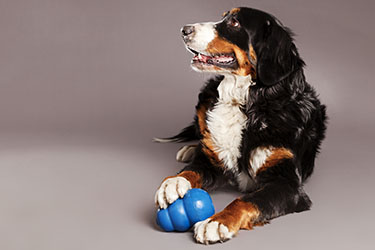Indoor Pet Enrichment Ideas

Engage your pet with indoor enrichment to stave off boredom this winter
You’ve probably seen toys, treat dispensers or even nesting items in animal enclosures at a zoo. From elephants that paint to tigers playing ball, environmental enrichment promotes normal behavioral expression through challenges, opportunities or stimulation provided to captive animals. Enrichment is designed:
- to help captive animals exhibit natural behaviors
- to increase exercise and exploration within their environment
- to offer choices and a sense of control over their surroundings
- to support positive mental health
Enrichment programs include variety in food, objects, toys, nesting material and even unique scents. Enrichment isn’t only for zoo, sanctuary or shelter animals. As seasonal weather keeps us indoors, enrichment opportunities are equally important for pets to keep them from developing physical or behavioral health issues. Remind your clients that, just like humans, pets can put on weight or feel stir crazy due to sedentary behavior in the winter months.
Types of enrichment opportunities
According to The Ohio State University College of Veterinary Medicine, enrichment techniques fall into five categories:
- Food based
- Sensory
- Novel objects
- Social
- Positive training
Start by thinking of what activities a pet would normally do, and then develop ways to satisfy those behaviors, even when indoors.
Indoor enrichment activities for dogs
Even though dogs get outside during the winter months, the short potty breaks are usually not enough to keep him physically and mentally active. While a rousing game of fetch may not be possible, there are ways to keep your pooch from feeling the effects of cabin fever.
A food-based enrichment can include hiding food in small toys, like a ball or KONG®. Stuff small pieces of kibble in peanut butter or pumpkin within the toy, then freeze it to make it even more challenging.
Sensory enrichment involves one or more of the senses of sight, smell, touch, hearing or taste. Find a nubby chew toy or play tug of war with a rope. Play hide and seek so the dog must rely on his sense of smell to find you, a toy or hidden food.
Novel objects may be adding a new box or blanket to explore. Novel just means it’s something new or unique added to their environment.
Social enrichment can be simply spending more quality time with your dog. If your dog is very social, have your friends bring their pets over to visit. Brave the cold to go to the dog park or consider doggie day care a few days a week.
Positive training techniques must be fun both for you and the dog. Teaching new tricks or behavior can be a great bonding experience. Positive reinforcement is crucial here. If you become frustrated or the pet becomes fearful, stop immediately.
Enrichment for indoor cats
Cat behavior can include stalking, climbing or hiding. How can a pet owner encourage those behaviors? While outdoor cats can explore their environment more freely, enrichment opportunities are especially important for indoor cats.
A food-based enrichment can include hiding food in small toys, like a ball. In addition to having to find the toy, the cat experiences chasing and catching the toy and then eating the hidden treats.
Sensory enrichment involves one or more of the senses of sight, smell, touch, hearing or taste. Possibilities are nearly limitless here. Put on a TV channel that broadcasts the sounds and images of flying birds. Put out a scratching post. Introduce new smells that cats would enjoy. Buy a toy with feathers or string.
Novel objects may be adding a new box or bag for the cat to explore. We’ve all seen the “if I fits, I sits” memes showing cats stuffing themselves into irresistibly small spaces.
Social enrichment can be simply spending more quality time with your cat. If your cat is very social, then consider having friends bring their pets over to visit, or even adding another pet to your household.
Positive training techniques must be fun for the cat and pet parent. Trying to force the issue can result in frustration or fear.
For more ideas for your clients, suggest that they download Keeping Cats Indoors, developed by The Ohio State University Veterinary Medical Center.
For articles written to the veterinary practitioner regarding the importance of implementing feline environment enrichment, OSU offers several resources and references.
Covetrus helps you care for the animals in your community. Visit us online or contact your Covetrus representative at 855.724.3461 to order supplies and medications for your practice.
Sources:
https://wildwelfare.org/enrichment-animal-welfare/
https://www.fortworthzoo.org/animal-enrichment-program
https://indoorpet.osu.edu/dogs/environmental_enrichment_dogs
https://indoorpet.osu.edu/sites/indoorpet/files/assets/documents/KeepingCatsIndoors-2013.pdf
https://indoorpet.osu.edu/veterinarians/environmental-enrichment-resources-and-references
Need Regulatory Assistance
If you need help with regulatory or licensing issues, we're happy to help. We have a wide variety of resources to help you when issues arise.

Careers
Are you looking for a place to let your talents shine? At Covetrus, we help our practitioner customers better serve their patients and take pride in providing the best customer experience possible. Search our open positions to see our available opportunities.
Newsletter
Stay current with what’s going on with Covetrus, subscribe to receive our newsletter and email communications. Subscribers will receive the latest information in practice management, sales and marketing, animal health, and more.


Leave a comment